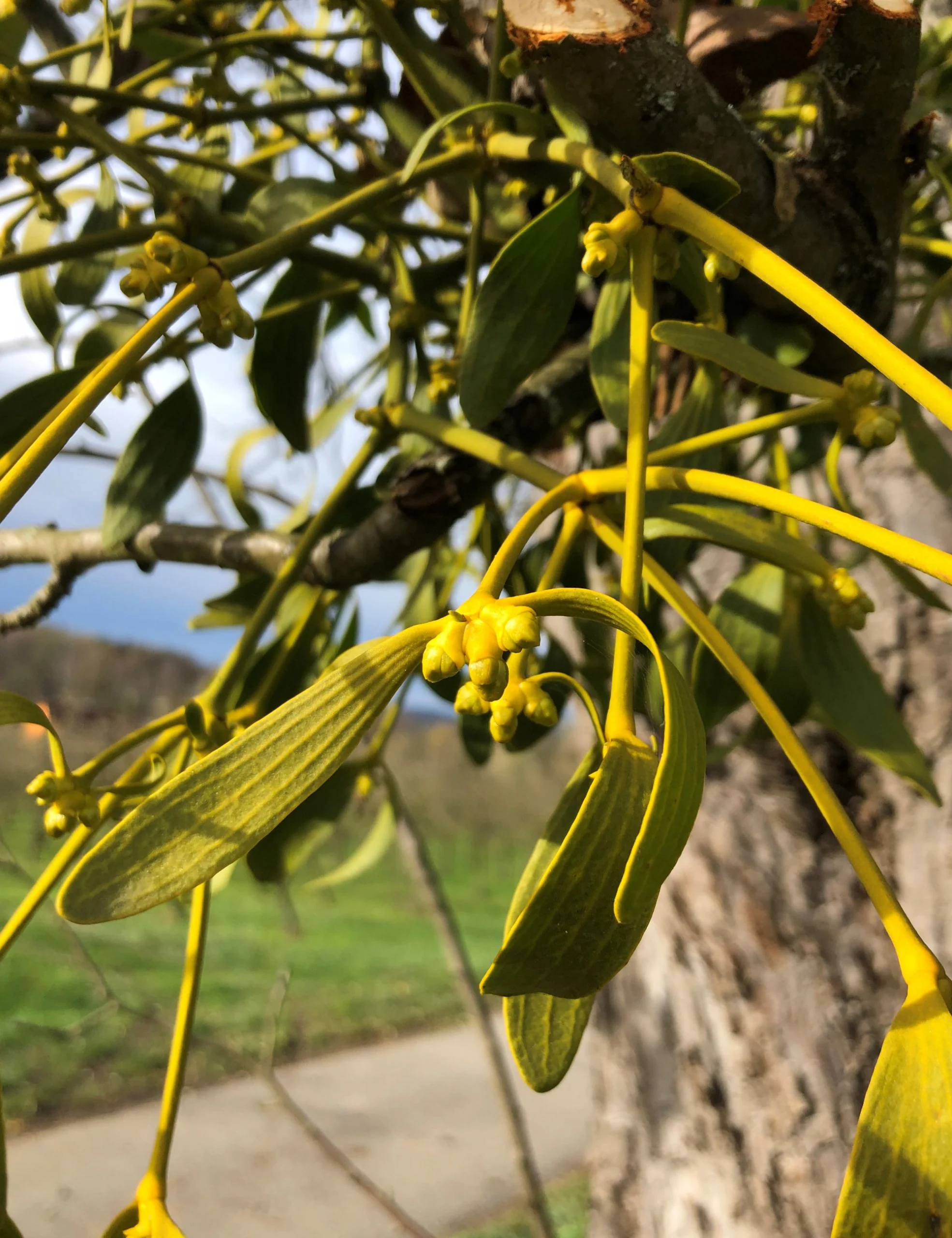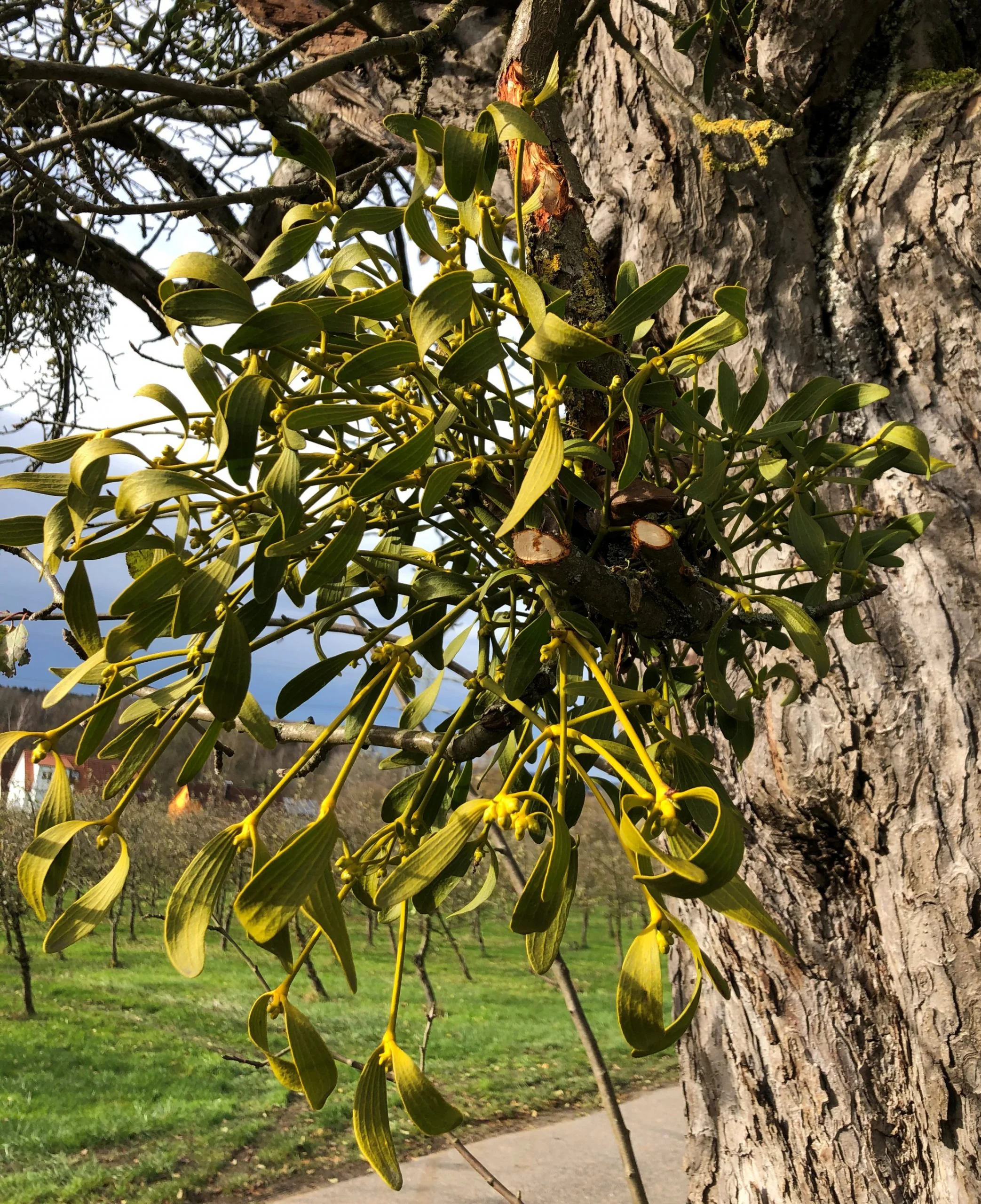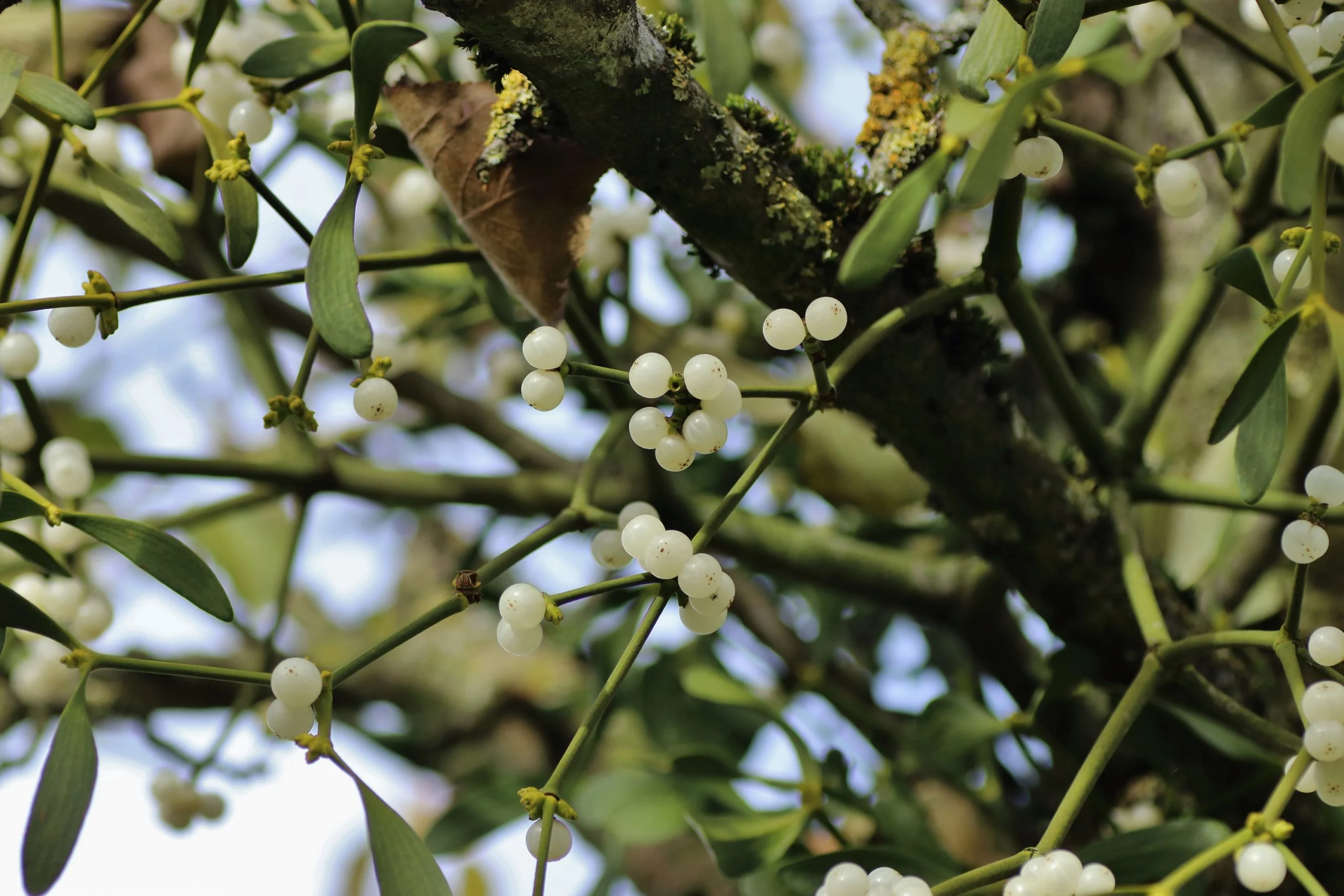8 Minuten Lesezeit
The european mistletoe (Viscum album) is considered by many to be a plant disease. But it is also a very old medicinal plant.



~ weak poisionous plant ~
Occurrence and distribution: The european mistletoe grows mainly in hardwood plantations, parks, orchards and meadows. It is usually also found on surrounding trees. The plant is spread among others by birds, which love to eat the fruits. The european mistletoe can be found in almost the whole of Europe. In Northern Europe (Scandinavia) it is only rarely found.
Plant description
Growth habit: The european mistletoe (Viscum album) is a semi-parasitic plant that spreads on hardwood trees. The mistletoe balls partially damage the host plant in the process, as they extract water and minerals from the tree. They form so-called “sucker roots / bark roots”, which parasitize into the branches of the trees. The plant has a spherical outline. Often, not only one of these mistletoe balls forms on the infested trees, but several. Infested trees often have to be cut down or pruned back in agriculture.
Common host plants: The most common host plants of the european mistletoe include apple trees, rowan trees, oaks, linden trees, maples, and willows. Less commonly, they are also found on hawthorns. Very rare to no records have been made on fruit trees such as pears, cherries, plums and damsons.
Leaves & Stems: The plant consists of a richly branched bush. The color of the stems ranges from yellow-green to a dark green. The leaves are leathery rough. They have an inverted oblong-ovate shape. The leaves are opposite at the end of the stems.
Flowers: The flowers have a pale yellow to green color and consist of 4 petals but without a pistil in the middle. It is a dioecious flower. The inflorescences are usually in several densely packed flowers together. The flowering period is from March to April (more rarely to May).
Fruits: The fruits consist of a white berry. The fruits contain a sticky pulp. Ripening period of the berries is during December. The dispersal of the contained seeds is done by certain birds. These eat the mistletoe berries and release the undigested seeds. These then adhere to the branches of other trees. From this, new mistletoe plants grow again.
Poisonous plant – Tips for handling
Poisonous plant: The plant is slightly poisonous. It has a weak toxic effect when eaten. Neither the berries nor the leaves are recommended for human consumption. Due to the contained ingredients, among other things, the mucous membranes of the digestive tract become slightly irritated.
Ingredients: Lectins (Viscumin – between 0.05% to 0.2%), Thionins (Viscotoxins)
LD50 for animals: unknown / no records available so far
The european mistletoe in folk medicine
The european mistletoe in folk medicine: One of the most well-known folk medicine is probably mistletoe tea. This is produced from mistletoe branches and mistletoe leaves. The priest Kneipp wrote about the tea: “The tea of european mistletoe stops the flow of blood. I could list a number of cases where a single cup was enough to stop the flow.“ A mistletoe wine was also made in former times from the mistletoe leaves and the thousand-gold herb. This was said to provide relief in cases of loss of appetite. However, it is not recommended to make and use one’s own medicine, as it is a weakly toxic plant. In an incorrect dosage, it can cause side effects.
Folk names & name origins
Folk names: The european mistletoe is known by various folkloric names. One of these is “white-berried mistletoe”.
Name origin: The botanical genus name “Viscum” is etymologically derived from the latin word „viscum“. The word can be translated into english as “glue / adhesive”. This can be derived from the sticky berries. For a further explanation, see also “Special features -> Bird glue”. The botanical species name “album” can be derived as a fief word from the latin adjective “albus” – in english “white”.
The derivation of the German name “Mistel” is uncertain to not determinable. There are some theories about the origin of the name. One possibility is a derivation from the word “Mist” (german word for „dung“). This can be derived from the Middle Low German word “migen” – German Streu / Mist (also „dung”). However, already Heinrich Marzell – an important biologist – expressed major doubts about the theories in the 1950s. Another explanation could be the Indo-Germanic word “mejgh”. This is said to translate into modern German as “urine, feces”. Further explanations can be found in the following source: BALLES, I. (1999): Zum germanischen Namen der Mistel: Für Helgo Bran, Loranthologe. Historische Sprachforschung,
Symbiosis with various birds and insects
Symbiosis with with certain bird species: The european mistletoe has entered into a kind of symbiosis for seed dispersal with certain bird species. The mistle thrush is probably the best known representative of the “visciphilic” bird species. Especially in winter, this thrush species prefers the white berries in the trees. The birds “snack” on the flesh of mistletoe berries. The seeds often stick to the birds’ beaks. This is to encourage the birds to perform the so-called beak care. The seeds then stick to new branches and thus spread the plant. Another bird species is the blackcap. It uses the white berries mainly as food for its brood.
Mistletoe insects: The mistletoe weevil (Ixapion variegatum) has specialized to live on and in mistletoe. Two butterfly species have adapted to mistletoe as a caterpillar food plant. One of these is the “mistletoe reel” (Celypha woodiana) and the mistletoe glasswinged butterfly (Synantedon loranthi). These are closely associated with the plant.
Special characteristics
Production of bird glue (Vogelleim) from the “oak mistletoe”: Bird glue used to be made from the sticky seeds of the related oak mistletoe (Loranthus europaeus). This was already produced at the time of the Celts. The unripe grapes were collected at harvest time. The grapes are dried and crushed dry. Then they must be soaked in water for 12 days. During this process the berries rot a little. The resulting pulp is further crushed with a pestle. The skins must be separated from the flesh. From the resulting flesh is made bird glue. To thicken the mixture was also often used honey or thickened prune juice.
Mistletoes in fineart
Mistletoe worship among the Gallic people: Among Druids, there was nothing more sacred than the mistletoe. The most important offerings were made by the druids, especially under mistletoe-bearing trees.
Use of mistletoe: Especially in England, the mistletoe branches are a popular Christmas decoration. It is an English custom to hang mistletoe on the ceiling of the room at Christmas. When the mistletoe is hung over the stable doors, it is said to protect the house from lightning, fire, disease and evil spirits. The custom of kissing girls under the mistletoe in the Christmas room also comes from this region.
The Advent wreath and mistletoe: In addition to the classic fir greenery, mistletoe branches were also sometimes incorporated into the Advent wreath in the past. However, this tradition has almost fallen into obscurity nowadays.
Mistletoes in artworks: European mistletoe is a popular motif in art. They are mainly used as a motif for earrings, necklaces and rings. But mistletoe branches were also printed on plates and cups as so-called “mistletoe dishes” in England. Another special form of art are the “stamps”.
Endangerment of the plant
Endangerment of the plant: The plant is currently not under protection. It is not yet classified as endangered on the German Red List.
Distribution-codes: A, AV, M1, M2, F